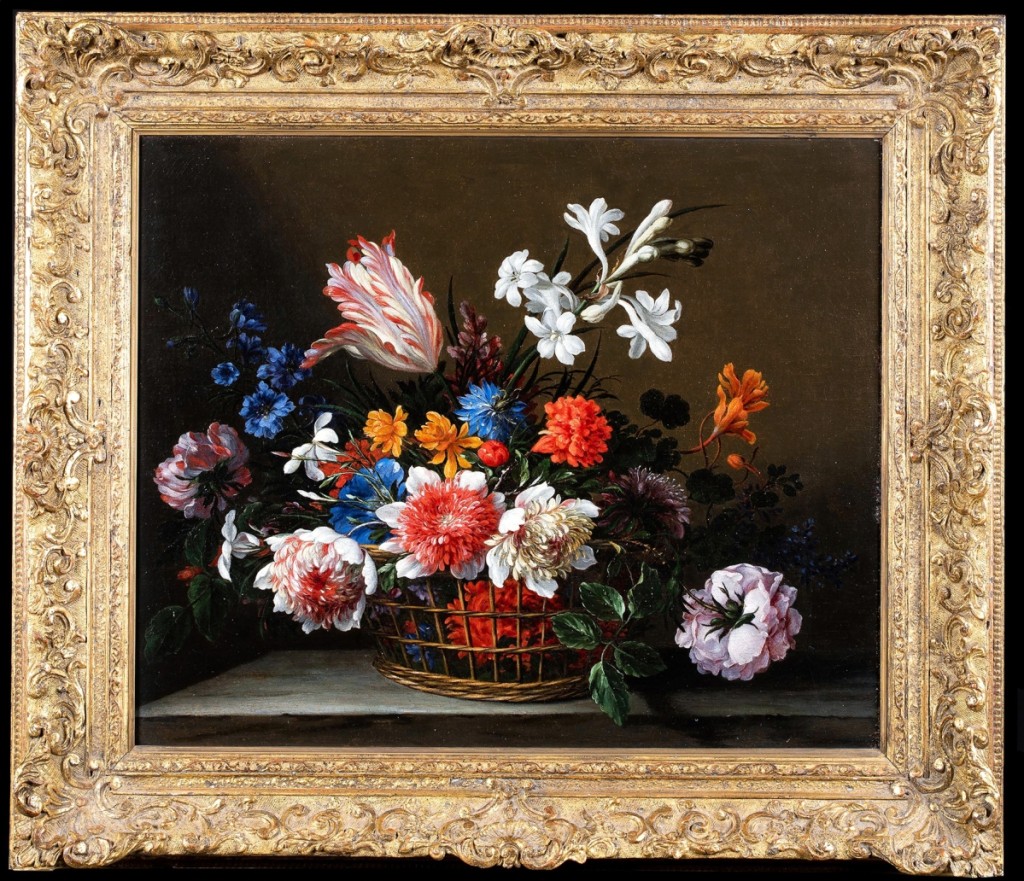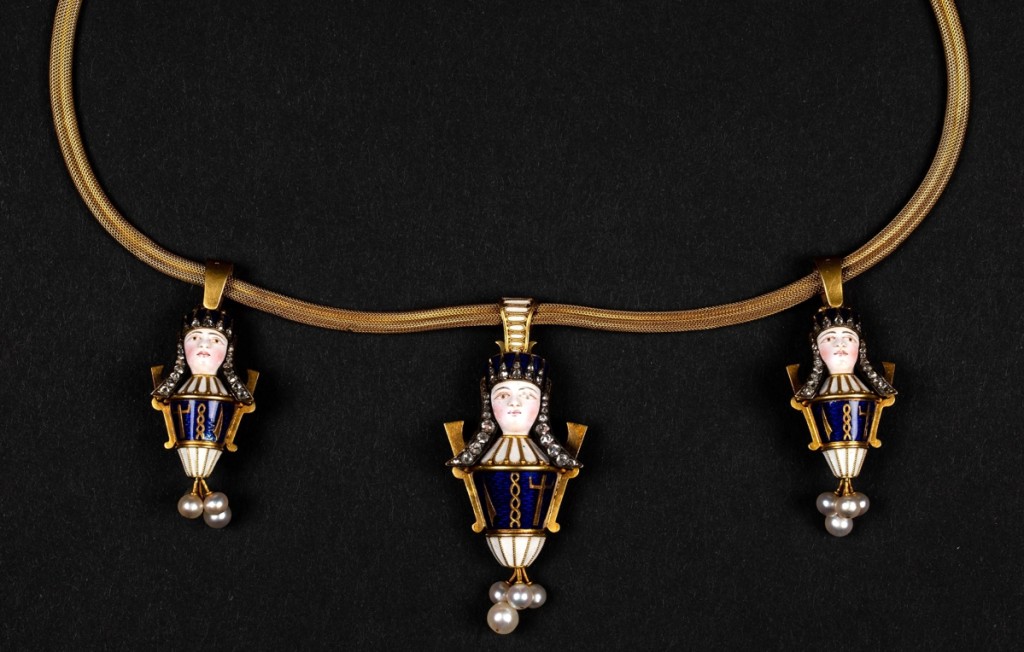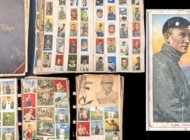
Two items in the sale were tied for top dollar. One was this Seventeenth Century still life by Dutch-French painter Jean-Baptiste Monnoyer. It showed a basket of flowers and had been sold by Sotheby’s in 1988 for $60,000. This time it went out for $24,000.
Review and Onsite Photos by Rick Russack, Additional Photos Courtesy The Cobbs
PETERBOROUGH, N.H. – Charlie Cobb knew he had some high-quality items, as well as some unusual items. Discussing them before the October 26 sale, he pointed out some things that he expected would do well. In nearly every case, he was proven right. An Egyptian Revival necklace and a Seventeenth Century Dutch still life each sold for $24,000. Some of the other jewelry and paintings did well, although some were disappointing. A very unusual American campaign slant-front desk exceeded expectations, as did some of the well-described historic firearms and swords. The sale included Midcentury Modern furniture, French cameo glass, a good selection of Asian material, some Oriental rugs and some items that were undoubtedly one of a kind.
There were about 75 bidders in the room, two internet platforms were in use, several phone lines were active and absentee bidders were successful on many items. Consider this: commenting on the challenges of competing in today’s marketplace, Cobb said that Invaluable alone had 46 auctions listed for the date; buyers had thousands of choices for the day.
Cobb has been getting some good jewelry lately, and one of the top priced items of the day was a Nineteenth Century necklace in the Egyptian Revival style. Selling for $24,000 on a single absentee bid, it had been made and signed by Carlo Giuliano (1831-1895). Before going into business for himself, Giuliano had worked with Casa Castellani, an Italian jeweler whose creations were based on archeological excavations and that would appeal to wealthy “Grand Tour” tourists. Giuliano opened his own showroom in London in 1860. This gold necklace featured three Egyptian Revival pendants, the largest of which was 2 inches long, royal figures in blue and white enamel in gold with diamonds and pearls, and it was marked “CG” on the back of the large pendant. Each was suspended from a 16-inch-long woven gold chain. A ruby and diamond brooch, which could be converted to dress clips, earned $6,600. It had a total of 32 rubies set in unmarked platinum. The consignor dated it to the early Twentieth Century and attributed it to Van Cleef & Arpels. A platinum and gold ring with a GIA-certified 2.26-carat natural yellow diamond, estimated $15/20,000, did not sell, but Cobb later said that he was discussing it with a customer who was thinking of buying it as a gift for his wife.
The painting that tied with the necklace for top honors of the day was a bright still life by Dutch-French painter Jean-Baptiste Monnoyer (1636-1699). It showed a basket of flowers and had been sold by Sotheby’s for $60,000. That receipt accompanied the painting. The artist also created engravings of flowers, which were used by tapestry makers. His works are in the Louvre and the Palace of Versailles. An Old Master school portrait of an elderly man reached $3,000, well over its estimate. Cobb said that it had probably been cut from a larger painting and said that blacklight did not show any restorations.
The paintings selection also included a number of English and American works, which included works by White Mountains artists. A panoramic, but unidentified, mountain scene by Benjamin Champney earned $5,700, despite some in-painting and a small tear. A scene he did of Mount Kearsarge went to an internet bidder for $2,160. Another Champney, a later work depicting a vase of yellow flowers, went out for $390. As Champney aged and was unable to frequently leave his Conway, N.H., studio, he often did still life works like this one. A woodland scene of birch trees at Jackson, N.H., by Frank Henry Shapleigh (1842-1906), brought $960. There were several other White Mountains paintings.

There were several nice pieces of jewelry in the sale. This Egyptian Revival necklace was one of the two items that each sold for $24,000. It had been made and signed by Carlo Giuliano while he worked in London. It was meant to appeal to wealthy clients who had taken “The Grand Tour.”
An usual piece of American furniture tripled its estimate, selling for $3,600. It was a cherry slant front desk with a large shell carved into the drop front. Slant front desks these days sometimes don’t bring more than $500. But this was a “campaign” desk in two sections, with the large heavy brass handles on the sides that one normally sees on Asian campaign furniture. Both before and during the sale, Cobb commented that he had never seen the form before. The gentleman who purchased it said the same thing. “I saw the desk and knew it was very unusual. I mentioned it to neighbors of mine, a Polish couple, who have been buying some nice things. When I said that I was going to the auction, we discussed whether I should bid on it for them. I think I may have bid a bit more than I was supposed to, but that’s okay. I wanted them to have it. They’ve been very helpful to me, and if I have to pay for some of it out of my own pocket, that’s okay.” The desk had a stepped interior and was cataloged as “North Shore/New Hampshire, old refinished surface.”
Another unusual piece of American furniture also exceeded its estimate. It was a country Chippendale sofa, cataloged as New England, late Eighteenth Century, with a splat back and a rope seat support. It had square, straight legs of mahogany with secondary woods of cherry, birch and poplar. It sold to an absentee bidder for $2,700.
The selection of military items included two items of particular historical interest. One was cataloged as a circa 1800 Native American musket in “as-found” condition. “This appears to be a circa 1800 flintlock military musket, not a trade piece. This is based on the fact that the trigger guard is fitted for a sling attachment, and generally trade muskets did not have this feature. Possibly this was a battlefield pick-up that was then used by a warrior. Relic condition with cracks and oxidation. The barrel is secured to the stock by rawhide strips which were wet before installing so they would shrink and tighten. It’s .69 caliber, which was the standard US military caliber of the era.” It sold for $1,680 to an internet bidder. A well-documented New Hampshire Civil War officer’s sword also did well. The catalog states, “It belonged to 1st Lieutenant Heber J. Davis of Hancock, N.H. The Ames Manufacturing. Co. Model 1850 staff & field officer’s sword is in excellent condition. The etched and polished blade is in like-new condition with scroll work, an American Eagle and other design features. Davis served in a number of theatres, including Florida, South Carolina and Virginia, saw action in a number of battles and was wounded three times. He was discharged on March 27, 1865, due to his wounds. A folder of military documents (muster rolls, discharge papers, etc), a biography and two photographs of Davis, one in military uniform accompanies the sword.” It sold for $2,040. The top selling item in the firearms portion of the sale was a special order Winchester Model 1886 45-70 rifle. It had a 28-inch octagonal barrel with like-new rifling, and it retained about 85 percent of the original bluing.” It realized $11,400.
This was a varied sale with some unusual items that could have been purchased inexpensively. One was a carved tern made on Pitcairn Island, populated by survivors of the famous mutiny on the HMS Bounty. It was made by Oscar Clark, a descendant of the mutineers. Birds like this one, and flying fish, are carved to be sold to visitors from passing ships and yachts, helping islanders to supplement the stipend they received from the British government. The carving brought $96 from a bidder in the room.

The highest priced firearm was this special order Winchester Model 1886 45-70 rifle with a 28-inch octagonal barrel. It realized $11,400.
Another unusual and probably unique item was a shadow box display, nicely framed, showing the life of a cultured pearl and the oysters that produced them. The shadow box contained a number of oyster shells, showing their size at different ages, starting with a very small shell from a one-month-old oyster to a large shell from an adult five years old. Each was neatly identified, and the case also included seven cultured pearls and shell-style flowers and vines. Likely to be the only one in the neighborhood, it reached $180.
A few days after the sale, Cobb said, “We were surprised at how many items were sold to internet and other absent bidders. That percentage keeps growing – most of the day after the sale we spent sending out invoices. Clearly, the internet aspect of the business needs careful consideration. We’ve been doing some online-only sales, and what we’re learning is that if the merchandise is exceptional and likely to be of interest to European or Asian buyers, those sales will do well. Americana-only online sales have not done that well yet, so we’re working to improve those sales.
The couple for whom the campaign desk had been bought came to pick it up, and they said they were delighted to have such a unique piece of furniture. All in all, I’d have to say that it was a good day for us.”
Prices given include the buyer’s premium as stated by the auction house. For additional information, 603-924-6361 or www.thecobbs.com























